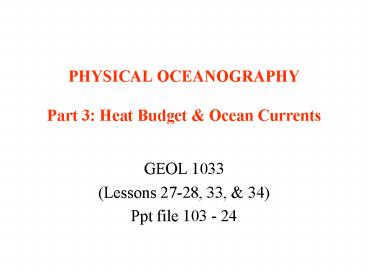PHYSICAL OCEANOGRAPHY Part 3: Heat Budget - PowerPoint PPT Presentation
1 / 24
Title:
PHYSICAL OCEANOGRAPHY Part 3: Heat Budget
Description:
Coriolis Effect in Northern Hemisphere. Shifts winds & ocean currents to the right ... Due to Coriolis effect, can get a weak countercurrent at depth ... – PowerPoint PPT presentation
Number of Views:69
Avg rating:3.0/5.0
Title: PHYSICAL OCEANOGRAPHY Part 3: Heat Budget
1
PHYSICAL OCEANOGRAPHYPart 3 Heat Budget
Ocean Currents
- GEOL 1033
- (Lessons 27-28, 33, 34)
- Ppt file 103 - 24
2
EARTH'S HEAT BUDGET
- About half of solar radiation, mostly as visible
light, reaches Earth's surface - Re-radiated energy is in the form of infrared
radiation - Carbon dioxide and water vapour temporarily
absorb some of this infrared (greenhouse effect
global warming)
half
Infrared radiation heat
3
LATITUDINAL VARIATIONS IN SOLAR RADIATION
- High latitudes receive less solar energy per unit
of surface area
4
LATITUDINAL VARIATION IN HEAT GAINS AND LOSSES
- Heat gains are greatest at lower latitudes
- Heat losses are relatively greater at higher
latitudes - Heat is redistributed by air ocean currents
5
Global Air Circulation Cells
Wet
Dry
Wet
Dry
Wet
6
Major Surface Wind Patterns
- Simplify this model look at surface winds
- Winds are mainly responsible for surface ocean
currents
7
Coriolis Effect in Northern Hemisphere
- Shifts winds ocean currents to the right
- Related to faster surface rotation rates near the
equator in comparison to those at higher latitudes
8
Influences on Oceanic Gyre Formation
- Winds cause currents
- Currents redistribute heat from Sun
- Coriolis effect shifts current directions to
right in N. Hemi. left in So. Hemi. - Continents block pure E-W flow, creating boundary
currents - Some gravitational influence
Northern Subtropical gyre
9
North Atlantic Gyre System
- Know these currents
- Western boundary currents (e. g., Gulf Stream)
are deeper, narrower, and faster than eastern
boundary currents (e. g., Canary Current) - Review Lessons 33 34
10
Major Ocean Surface Currents Climatic Zones
- Review Exercise 15 (Completed answer sheet on
page 235 is due next Thursday, Dec. 2nd.)
11
Circum-Antarctic Surface Circulation
- Less interference from north-south oriented
continental masses
12
REMEMBER THE PYCNOCLINE
- Halocline refers to the salinity increase
coinciding with the thermocline - Pycnocline is the density change associated with
the thermocline and halocline
13
REMEMBER LATITUDINAL VARIATIONS IN AVERAGE DEPTH
OF VERTICAL DENSITY ZONES
- Surface zone
- Pycnocline
- Deep zone
14
PACIFIC OCEAN Salinity/Temperature Structure
15
ATLANTIC OCEAN Salinity/Temperature Structure
16
Circulation of Atlantic Ocean Water Layers
- Note Antarctic Intermediate and Bottom Waters
- Find the North Atlantic Deep Waters
-
AC ? AD ?
17
Antarctic Ocean Upwelling and Downwelling
North Atlantic Deep Waters
18
- Stopped Here
19
Ekman Spiral
- Due to Coriolis effect, can get a weak
countercurrent at depth
20
Northern Hemisphere Coastal Upwelling and
Downwelling
- Coriolis right shift of surface waters (Ekman
spiral effect) - Onshore to produce downwelling
- Offshore to produce upwelling
21
Southern Hemisphere Coastal Upwelling and
Downwelling
- Coriolis left shift of surface waters (Ekman
spiral effect) - Onshore to produce downwelling
- Offshore to produce upwelling
- El Nino off NW coast of So. Am.
22
Circulation of Atlantic Ocean Water Layers
- Note Antarctic Intermediate and Bottom Waters
- Find the North Atlantic Deep Waters
- Note Med. Salty, warm water AC
? AD ?
23
The Oceanic Conveyor Belt
- Thermohaline surface to deep planetary
circulation system. - A disruption may bring on another Ice Age!
24
END OF FILE































![Heat Pumps Installation Auckland!! Heat Pump* [Special Offers] PowerPoint PPT Presentation](https://s3.amazonaws.com/images.powershow.com/9013285.th0.jpg?_=20180307031)